
Search Wild Foods Home Garden & Nature's Restaurant Websites:
Purslane
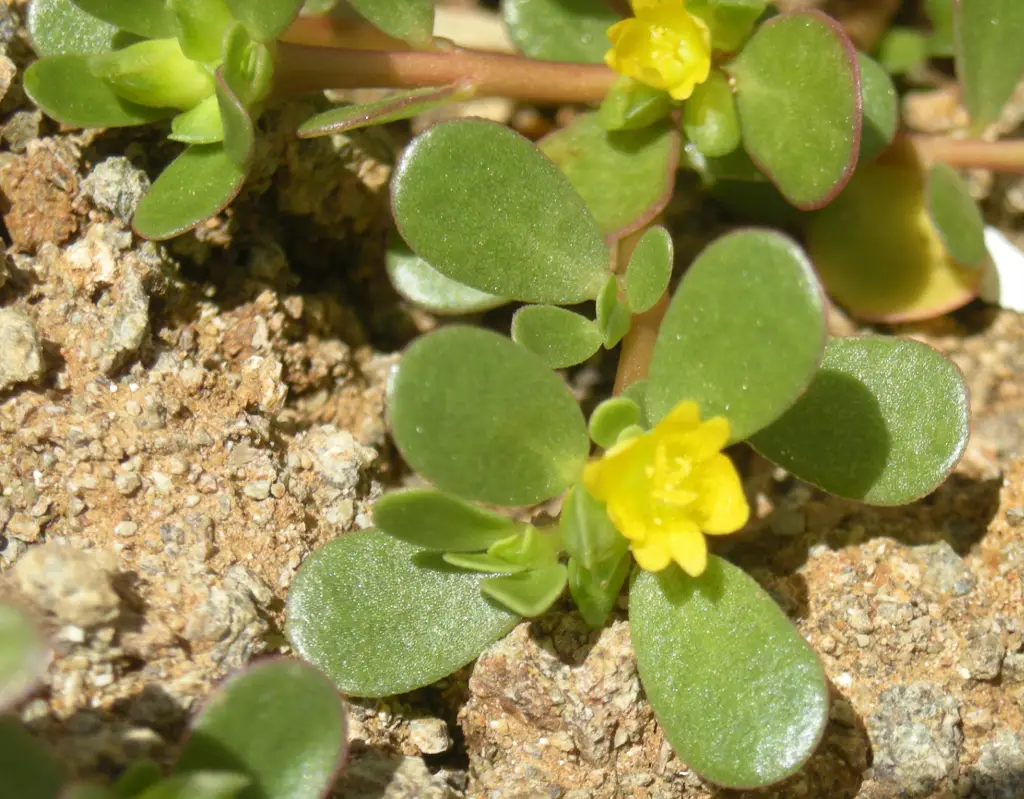
Close up of Purslane leaves and flowers. (By: Ethel Aardvark CC BY-SA 3.0)
(NOTE: If you are not interested in growing Purslane, but just finding the plant and using it, try going to the Nature's Restaurant Online site Purslane page.)
Purslane (Portulaca oleracea). Also called the Little Hogweed. It is a common “weed” most everywhere. It is, as the Latin name suggests, a very close relative of the Portulaca flower you can buy for your garden. This is a cultivated food crop in India, and it proves how smart that culture is because this is one of the best raw greens there is, period. It is just bizarre you can't buy this in grocery stores. The fact most of us in the west pull this "weed" from our gardens to give room to other plants that don't taste as good, or grow as well just makes me nuts. And the fact it wants to grow almost anywhere and never seems bothered by pests, makes it an ideal crop. Another great feature of this plant is it will do just fine in drought, though it will grow more with regular moisture.
Is the growing of this plant compatible with Natural farming, Ecoagriculture or Eco friendly agriculture, Ecological farming, Sustainable agriculture, Agroforestry or Agro-sylviculture and Permaculture: This one works with Natural farming, no-till garden methods, or conventional gardening. Once soil is prepared and it is planted for the first time, you don't have to turn the soil again. Fertilize with composted manure in the spring or fall. If you use conventional tilling gardening methods, turn the composted manure into the soil before replanting. This plant will self seed once established.
Seeds: Once you find a plant with the mature seed pods on the end of the stem, gather them, and save for next spring. You can also purchase seed for them.
Transplanting: This plant, if smaller, will transplant by taking a shovel full of soil under it. Often they will come up where you don't want them, and moving these to where you want them is fairly quick and simple.
Soil & Site: First off, best to grow them in full sun. They grow small in poor soil, and can grow quite large in excellent soil conditions. It can grow in a wide range of conditions, but one thing it does like is soils that are porous and drain the moisture - soils that don't leave standing water.
For years, I thought the plants were always small with tiny leaves - that was all I had seen. One day I was at a Hosta nursery just south-west of London, Ontario. While walking the grounds looking at all the different kinds of Hosta plants, I saw this massive Purslane growing between two Hostas. It was so big, I doubted whether it was a Purslane. It had leaves that were about 5 cm (2 inches) long, red stems as thick as pencils and sat there about 16 inches off the ground like a small shrub. I was mesmerized by it. I reached down, picked a leaf and started to eat it slowly - I still doubted something that big could be a Purslane. It was a Purslane, and was it ever good - crisp, lemony and fresh tasting. I went and asked the woman who I assumed was the owner of the place what she did to fertilize her plants, and she said she bought composted manure from local farmers. The area was naturally damp, but the beds were raised. From that beginning, I have confirmed, it does its very best on neutral, well drained, moist soils with composted manure mixed through, and full sun.
Planting: Sprinkle the seeds over the area you want them. Lightly rake the soil, tamp the soil, and you are done. They should come up, and keep coming up year after year as long as you let some go to seed. Plant when the soiled has warmed up well after last chance of frost. As I've mentioned for other small seed plants, I've learned the best way to get an even distribution is to first mix the seed well in a bucket half filled with slightly damp potting soil, then spread the soil around and tamp down. No need to cover this with any more soil in this case. Just water to not let the soil dry out until they come up.
Maintenance: Nothing.
Harvesting: An odd feature of this green vegetable that the earlier in the day you pick it, the stronger the lemony bite of the taste, and the later in the day you pick it, the milder it is. Try tasting it different times during the day and you will find a time it suits your taste best.
Using: This is an amazingly versatile food. All parts of the plant above ground are usable in salads, stir-frying, soups, almost anything. In salads, it ads a zing to the flavor, like a natural vinegar. In soups it acts as a thickener. In a stir-fry it acts like Okra (Abelmoschus esculentus) (not my own favorite texture, but many do like it). I like it best as a salad green or just eating a handful when I find them. Very good raw taste, and nice crisp texture. Eat the stems, the flowers and all. Just cut or snap a section off, rinse and eat.
Description:
- USDA Plant Hardiness Zone: 5-10 (More information on hardiness zones).
- Soil pH: 5.5-7.0
- Plant Size: Can reach as high as 40 cm (16 inches), but found most often a few centimeters off the ground acting like a Prostrate shrub, that is growing out horizontally from the base along the ground. Very often you will see them with horizontal stems coming from a single, central root spreading out in a circle shape.
- Duration: Annual
- Leaf Shape: Obovate (oar-shaped), very thick leaf (it is a succulent plant).
- Leaf Phyllotaxis (Arrangement) on branch: Alternate in clusters at end of stems.
- Leaf Size: 1.25-5 cm (1/2 to 2 inches) long
- Leaf Margin: Entire (smooth edged)
- Stems: Dull red, sometimes green with red hue. Edible (same as leaf)
- Flowers: Small (0.5 cm or less) bright yellow, five petalled.
- Fruit: little pods full of extremely small, black or reddish brown seeds
- Habitat: Anywhere in full light and disturbed soils - waste areas, fields, gardens. Able to tolerate poor, compacted soils and drought, but grows better in better soils
Web Resources:
- Recipe search on the web here (Google search) and here (Bing search).
- Pictures on the web here (Google images) and here (Bing images).
- Interactive USDA distribution map and plant profile here.
- The Biota of North America Program (BONAP) distribution map here. BONAP map color key here.
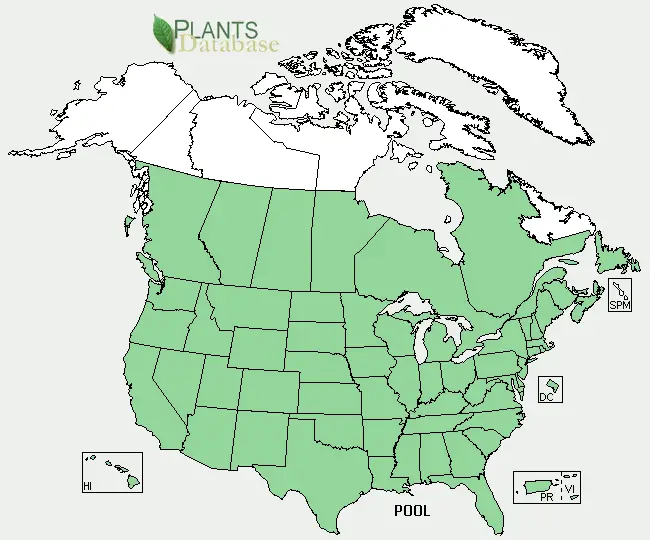
Purslane (Portulaca oleracea) range. Distribution map courtesy of U. S. Department of Agriculture (USDA Natural Resources Service) and used in accordance with their policies.
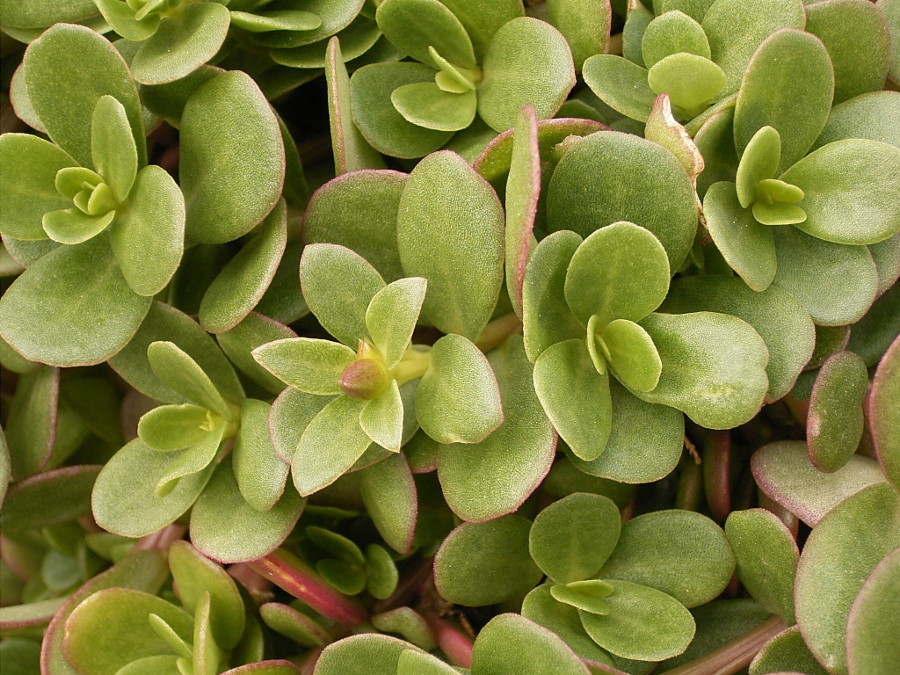
(By: Frank Vincentz CC BY-SA 3.0)
Glistrida Greek salad. (By: Lemur12 CC BY-SA 3.0)
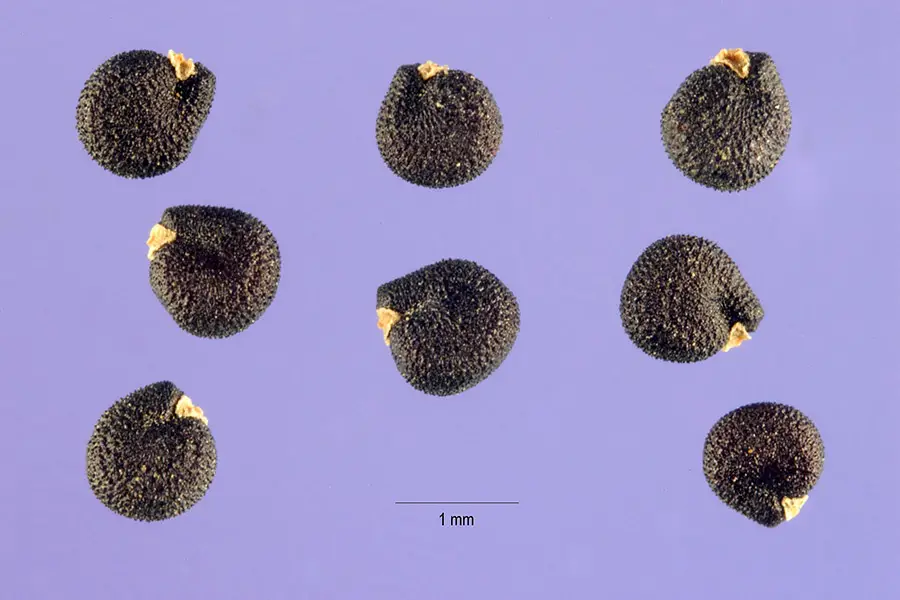
Purslane (Portulaca oleracea) seeds. (Steve Hurst, hosted by the USDA-NRCS PLANTS Database)
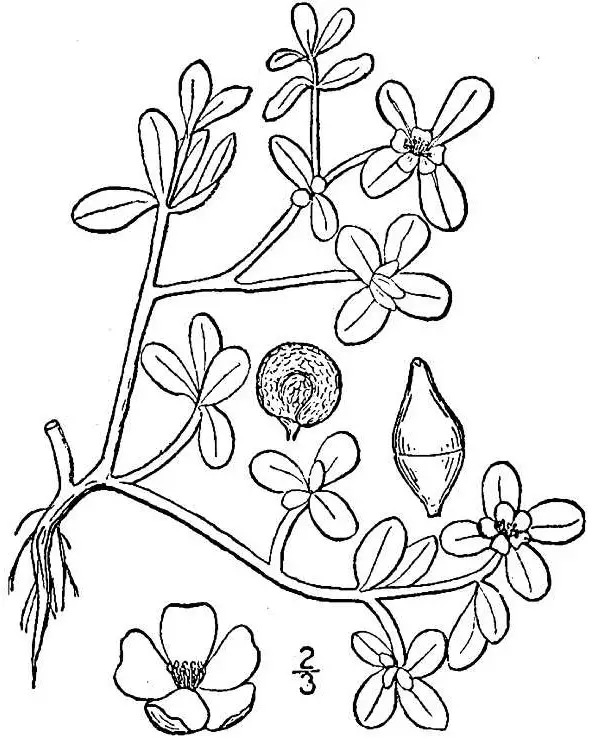
Drawing. (USDA-NRCS PLANTS Database / Britton, N.L., and A. Brown. 1913. An illustrated flora of the northern United States, Canada and the British Possessions. 3 vols. Charles Scribner's Sons, New York. Vol. 2: 40)

Purslane plant. The young stems are edible and tender too. This one was growing on dry, poor soil during a drought.
Search Wild Foods Home Garden & Nature's Restaurant Websites:
Share:
Why does this site have ads?
Originally the content in this site was a book that was sold through Amazon worldwide. However, I wanted the information to available to everyone free of charge, so I made this website. The ads on the site help cover the cost of maintaining the site and keeping it available.
Google + profile
